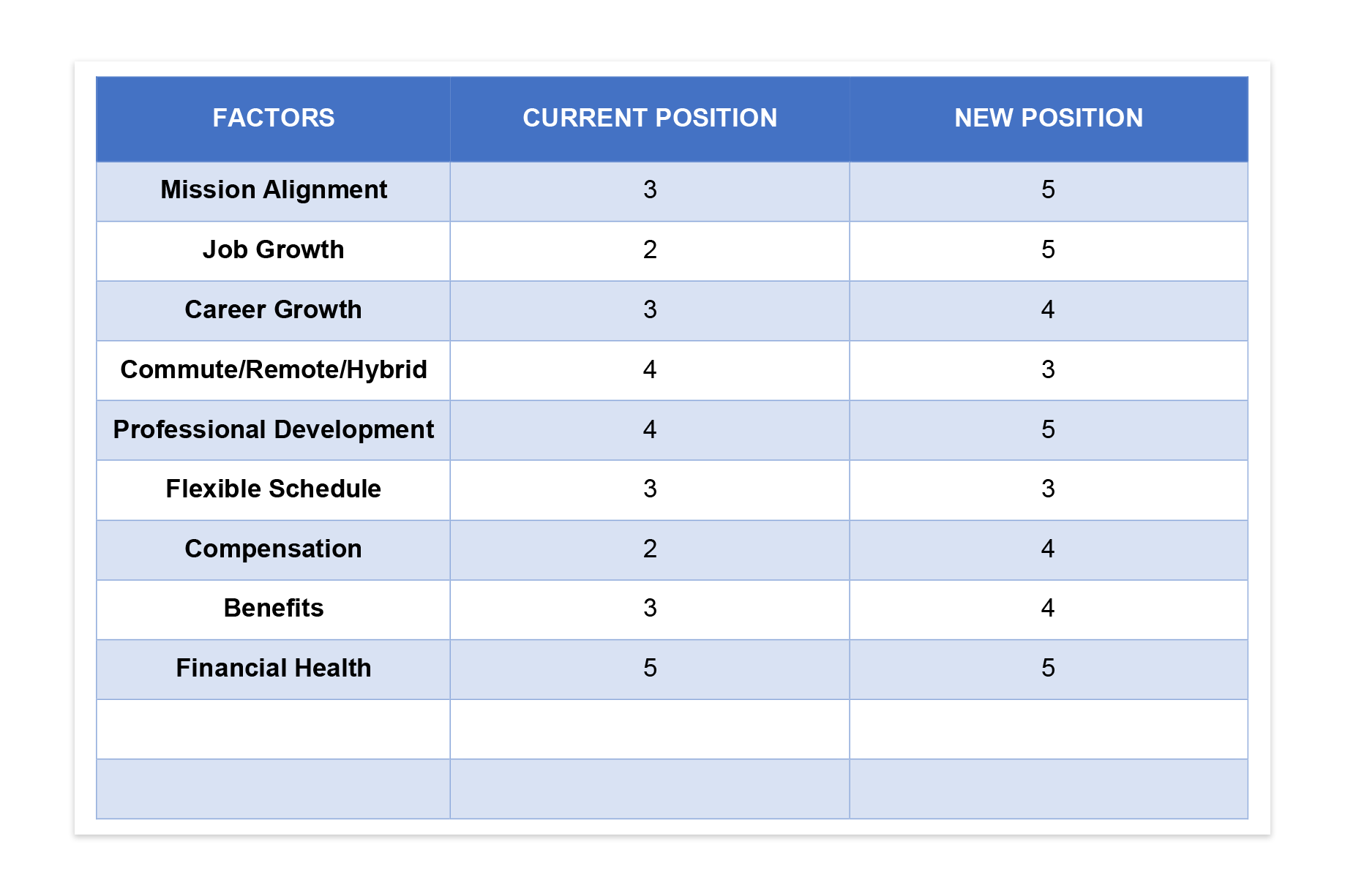Research is an important part of the job search process. But it can often take undue time and fail to yield the kind of information that will help you choose the right company and position. You need to know what to look for, where to find it, and most importantly, how to evaluate what you find. This guide will help you focus on what matters most, prioritize your time, and make an employment decision you can be satisfied with long term.
Develop a Personal Decision Framework
The power dynamic in hiring can be uneven. Candidates often feel that the employer holds all the cards and can easily lose sight of their own needs. Every employer has a standard—a framework—for evaluating their next employee. We recommend creating a framework of your own.
Creating a personal decision framework will help you organize your research, demonstrate your strengths in your resume, cover letter, and interview, and create a more equitable interaction between both parties. At this stage, you are figuring out which tradeoffs you’re willing to accept between what drives you, what you’re good at, what compensation you require, and the many ways that work impacts your life. Here’s how to begin thinking about that.
“You can find similar roles in so many different types of organizations, whether that’s a writer, program manager, recruiter, etc. Think about your values, what fascinates you, or what you connect with in some way.”
— Staffing Advisors Project Director Lilly Khan
Where to Research and What to Look For
Once you’ve thought about the factors that will impact your decision most when an offer is on the table, prioritize your research. If compensation is your primary objective, spend less time digging for clues about company culture. If you are most attracted to doing the work you love in an organization that makes a meaningful impact, spend more time learning about mission-focused initiatives.
Who They Are and What They Do
Look for information that tells you what problems the organization is trying to solve, how your skills and experience might help solve them, and if that’s something you’d like to do.
- Read through the company’s website and social media accounts and search the web for press releases and news.
- Here’s a short but insightful post from hiring consultant and former chief of staff Alison Green about what to look for, including how they see themselves, what they’re most known for, who their biggest clients and key players are, and what their current initiatives are. Alison emphasizes, “This isn’t research for you to then recite in the interview to show you prepared . . . it’s to inform your understanding of what they’re all about—which will help you have a more intelligent conversation with your interviewers because you’ll better understand their context.”
Company Culture and Values
Look for information about the dynamics between employees and management, norms relating to day-to-day work, and how the organization lives out its stated values.
- Check Glassdoor reviews for clues about work culture mentioned by more than one person. A single comment may not tell you much, but comments from a few employees with similar experiences point to culture.
- Many companies are in transition with regard to culture. Ask your interviewer where they are now and where they are going. Artfully framed questions can also uncover a goldmine of information in this area. These suggestions from Karen Eber, CEO of a talent development boutique and TED speaker, are a great place to start.
- A recruiter is a fantastic resource you can feel comfortable being direct with. At Staffing Advisors, we offer candidates details we gather through in-depth guided inquiry with our clients—it’s not information that can be found online. Our job is to pass that information along to you.
What It’s Really Like to Work There
A short conversation with a current or past employee can ground you in the realities of the workplace, offer some clues about culture, and uncover other details you may not have considered.
- Check current employees on LinkedIn for any connection you can reach out to directly. Read their profiles to see how they describe their work.
- Look at past employees to see how long they stayed and where they went next.
Financial Health and Stability
If an organization isn’t financially strong or its economic model isn’t sustainable, there won’t be enough money to take care of you as an employee.
- For nonprofits, check 990s for financial information. Executive salaries and funding priorities can help you assess whether you are looking at a scrappy start-up or an established organization and whether your department is likely to be well-funded.
- For-profit companies often publish annual earnings reports in the investor relations section of their website.
Organize Your Research
At Staffing Advisors, we love using scorecards and checklists to help candidates and clients evaluate complex information while keeping focus on the intended goals. You may be comparing a potential position to your current role, another position, or even multiple positions. A scorecard can make that comparison clearer while reducing the potential for making choices based on factors that are attractive but don’t support your needs.
List out the job factors that matter to you in order of importance. Using your research, rank each factor using a scale that works for you. Ideally, the factors you list first should rank high, aligned with your priorities. A sample scorecard using a 1-5 scale might look something like this:
Use Your Research to Ask Better Questions
Don’t waste valuable minutes at the end of your interview with generic questions. As you research, think about how you can use that information to ask questions, demonstrating that you understand the organization, the context of the hiring decision, and how the position differs from your current one. If you ask the right questions, you will not only look good, but you will also gain a clearer understanding of the position, the company culture, and whether you can work within that structure.
Here is some specific guidance on how to craft questions that will help you stand out and determine whether the role is right for you.
“No one wins when someone takes a job for the wrong reasons; we are seeing that now with this boomerang effect. So many people are leaving jobs that they just started. The hiring process is a two-way street. You have to get your questions answered. Some of it is online research, and some requires asking people. But you have to know what you are looking for and how to evaluate the opportunity based on that.”
— Staffing Advisors Vice President of Client Engagement Aileen Hedden
Don’t Forget About the Big Picture
So many of our conversations about work are focused on skill-building, ladder-climbing, and career growth. Those things matter to all of us in varying degrees and with widely varied definitions. But the reality for most people is that you hope you get to do something you’re good at with people you respect and like working with so you can live the type of life you want.

